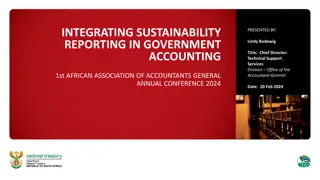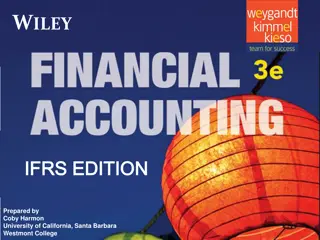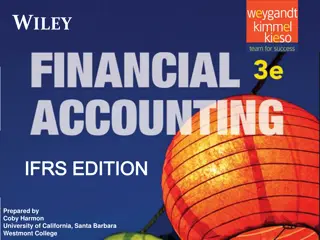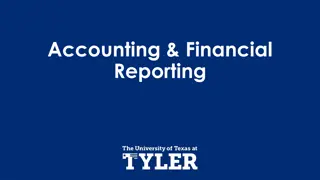Basics of Financial Accounting and Reporting
Financial accounting involves recording, summarizing, and reporting a company's transactions through statements like income statements, balance sheets, and cash flow statements. The process aims to provide relevant and faithfully represented information that influences stakeholders' decisions. Verifiability, comparability, and understandability are essential for effective financial reporting.
Download Presentation

Please find below an Image/Link to download the presentation.
The content on the website is provided AS IS for your information and personal use only. It may not be sold, licensed, or shared on other websites without obtaining consent from the author.If you encounter any issues during the download, it is possible that the publisher has removed the file from their server.
You are allowed to download the files provided on this website for personal or commercial use, subject to the condition that they are used lawfully. All files are the property of their respective owners.
The content on the website is provided AS IS for your information and personal use only. It may not be sold, licensed, or shared on other websites without obtaining consent from the author.
E N D
Presentation Transcript
TOPIC :FINANCIAL ACCOUNTING FACULTY NAME : A.ABDUL HAKEEM
Financial accounting recording, summarizing and reporting a company's business transactions through financial statements are: the income statement, the balance sheet, the cash flow statement and the statement of retained earnings. Financial accounting is the process of financial statements. These
Financial accounting and financial reporting are often used as synonyms. 1. According to International Financial Reporting Standards: the objective of financial reporting is: To provide financial information that is useful to existing and potential investors, lenders and other creditors in making decisions about providing resources to the reporting entity. 2. According to the European Accounting Association: Capital maintenance is a competing objective of financial reporting.
Relevance: to influence the decision of its users. The ingredients of relevance are the predictive value and confirmatory value. Materiality is a sub-quality of relevance. Information is considered material if its omission or misstatement could influence the economic decisions of users taken on the basis of the financial statements. Faithful Representation: actual effects of the transactions shall be properly accounted for and reported in the financial statements. The words and numbers must match what really happened in the transaction. The ingredients of faithful representation are completeness, neutrality and free from error. Relevance: Relevance is the capacity of the financial information Faithful Representation: Faithful representation means that the
Verifiability: different knowledgeable and independent users of financial information. Such information must be supported by sufficient evidence to follow the principle of objectivity. Comparability: accounting methods across entities in the same industry. The principle of consistency is under comparability. Consistency is the uniform application of accounting across points in time within an entity. Understandability: accounting reports should be expressed as clearly as possible and should be understood by those to whom the information is relevant. Timeliness: must be presented to the users before a decision is to be made. Verifiability: Verifiability implies consensus between the Comparability: Comparability is the uniform application of Understandability: Understandability means that Timeliness: Timeliness implies that financial information
Financial statements provide a picture of the performance, financial position, and cash flows of a business. These documents are used by the investment community, lenders, creditors, and management to evaluate an entity. There are four main types of financial statements, which are as follows: Income statement. This report reveals the financial performance of an organization for the entire reporting period. It begins with sales, and then subtracts out all expenses incurred during the period to arrive at a net profit or loss. An earnings per share figure may also be added if the financial statements are being issued by a publicly-held company. This is usually considered the most important financial statement, since it describes performance. Balance sheet. This report shows the financial position of a business as of the report date (so it covers a specific point in time). The information is aggregated into the general classifications of assets, liabilities, and equity. Line items within the asset and liability classification are presented in their order of liquidity, so that the most liquid items are stated first. This is a key document, and so is included in most issuances of the financial statements.
Statement of cash flows. This report reveals the cash inflows and outflows experienced by an organization during the reporting period. These cash flows are broken down into three classifications, which are operating activities, investing activities, and financing activities. This document can be difficult to assemble, and so is more commonly issued only to outside parties. Statement of changes in equity. This report documents all changes in equity during the reporting period. These changes include the issuance or purchase of shares, dividends issued, and profits or losses. This document is not usually included when the financial statements are issued internally, as the information in it is not overly useful to the management team.
1) Systematic record: The main function is to make systematic records of financial transaction of the business. Systematic records mean use standard of financial accounting and the nation s government guidelines to record each and every financial transaction of the business enterprises. 2) After recording the financial transaction of business in a systematic way, the team of financial accounting has to analyze and summarise the whole transaction to show the correct financial position of the business. The team will analyze it in Trail Balance and summarise it in the final account to know the profit or loss of business enterprises in a particular financial year. 1) Systematic record: 2) Analysing Analysing and and Summarising Summarising: :
3) Communicate results: The Team of financial accounting has to communicate results of business financial position of a particular financial year to all the parties. They will provide them with the Financial Statement: Shareholder/Owner(s) Government Investors. Other related parties like Creditor, debtors, money lenders, etc. 4) Meet legal requirements: The Team of financial accounting has to meet the legal requirement. like Audit the books of the particular financial year from external Auditor and paid tax liabilities as per the taxation system of the country law. 3) Communicate results: 4) Meet legal requirements:























